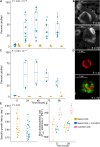Adsorptive exchange of coccolith biominerals facilitates viral infection
- PMID: 36662866
- PMCID: PMC9858585
- DOI: 10.1126/sciadv.adc8728
Adsorptive exchange of coccolith biominerals facilitates viral infection
Abstract
Marine coccolithophores are globally distributed, unicellular phytoplankton that produce nanopatterned, calcite biominerals (coccoliths). These biominerals are synthesized internally, deposited into an extracellular coccosphere, and routinely released into the external medium, where they profoundly affect the global carbon cycle. The cellular costs and benefits of calcification remain unresolved. Here, we show observational and experimental evidence, supported by biophysical modeling, that free coccoliths are highly adsorptive biominerals that readily interact with cells to form chimeric coccospheres and with viruses to form "viroliths," which facilitate infection. Adsorption to cells is mediated by organic matter associated with the coccolith base plate and varies with biomineral morphology. Biomineral hitchhiking increases host-virus encounters by nearly an order of magnitude and can be the dominant mode of infection under stormy conditions, fundamentally altering how we view biomineral-cell-virus interactions in the environment.
Figures






References
-
- A. R. Taylor, M. A. Russell, G. M. Harper, T. F. T. Collins, C. Brownlee,Dynamics of formation and secretion of heterococcoliths by Coccolithus pelagicus ssp braarudii. Eur. J. Phycol. 42,125–136 (2007).
-
- L. Mackinder, G. Wheeler, D. Schroeder, U. Riebesell, C. Brownlee,Molecular mechanisms underlying calcification in coccolithophores. Geomicrobiol. J. 27,585–595 (2010).
-
- P. L. A. M. Corstjens, A. Van Der Kooij, C. Linschooten, G.-J. Brouwers, P. Westbroek, E. W. De Vrind-De Jong,Gpa, a calcium-binding protein in the coccolithophorid Emiliania huxleyi (Prymnesiophyceae). J. Phycol. 34,622–630 (1998).
MeSH terms
Substances
LinkOut - more resources
Full Text Sources
Medical

